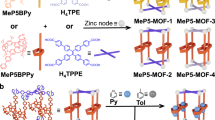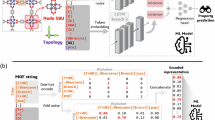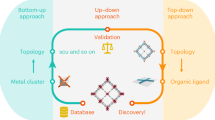Abstract
The properties and functions of metal–organic frameworks (MOFs) can be tailored by tuning their structure, including their shape, porosity and topology. However, the design and synthesis of complex structures in a predictable manner remains challenging. Here we report the preparation of a series of isomeric pillar-layered MOFs, and we show that their three-dimensional topology can be controlled by altering the layer stacking. This enables variability on the backbone structure, as well as diverse spatial arrangements of pillars and the partitioning of pore space into several kinds of cages packing in distinct sequences. These sequence-controlled MOFs (SC-MOF-1–6) showcase ultrahigh benzene capture capacities at low-pressure and high volumetric and gravimetric uptake performances in high-pressure methane storage. We provide the construction principles of the SC-MOFs and predict nearly 2,000 possible SC-networks with sophisticated composition sequences at the atomic level by using a Python script.

This is a preview of subscription content, access via your institution
Access options
Access Nature and 54 other Nature Portfolio journals
Get Nature+, our best-value online-access subscription
27,99 € / 30 days
cancel any time
Subscribe to this journal
Receive 12 print issues and online access
269,00 € per year
only 22,42 € per issue
Buy this article
- Purchase on SpringerLink
- Instant access to full article PDF
Prices may be subject to local taxes which are calculated during checkout






Similar content being viewed by others
Data availability
All crystallographic data have been deposited with the Cambridge Crystallographic Data Centre, with reference numbers 2236913 (SC-MOF-1), 2236914 (SC-MOF-2), 2236915 (SC-MOF-3), 2236916 (SC-MOF-4), 2236917 (SC-MOF-5) and 2387166 (SC-MOF-6). Copies of the data can be obtained free of charge via https://www.ccdc.cam.ac.uk/structures/. All other data are included in the Supplementary Information. Source data are available via figshare at https://doi.org/10.6084/m9.figshare.27828132 (ref. 54). Source data are provided with this paper.
Code availability
The Python script is available via figshare at https://doi.org/10.6084/m9.figshare.27828132 (ref. 54).
References
Yaghi, O. M. et al. Reticular synthesis and the design of new materials. Nature 423, 705–714 (2003).
Kitagawa, S., Kitaura, R. & Noro, S. Functional porous coordination polymers. Angew. Chem. Int. Ed. 43, 2334–2375 (2004).
Zhang, J.-P., Zhang, Y.-B., Lin, J.-B. & Chen, X.-M. Metal azolate frameworks: from crystal engineering to functional materials. Chem. Rev. 112, 1001–1033 (2012).
Li, J.-R., Kuppler, R. J. & Zhou, H.-C. Selective gas adsorption and separation in metal–organic frameworks. Chem. Soc. Rev. 38, 1477–1504 (2009).
Sumida, K. et al. Carbon dioxide capture in metal–organic frameworks. Chem. Rev. 112, 724–781 (2012).
Adil, K. et al. Gas/vapour separation using ultra-microporous metal–organic frameworks: insights into the structure/separation relationship. Chem. Soc. Rev. 46, 3402–3430 (2017).
Lee, J. et al. Metal–organic framework materials as catalysts. Chem. Soc. Rev. 38, 1450–1459 (2009).
Corma, A., García, H. & Llabrés i Xamena, F. X. Engineering metal organic frameworks for heterogeneous catalysis. Chem. Rev. 110, 4606–4655 (2010).
Cui, Y., Yue, Y., Qian, G. & Chen, B. Luminescent functional metal–organic frameworks. Chem. Rev. 112, 1126–1162 (2012).
Zhang, Y. et al. Luminescent sensors based on metal-organic frameworks. Coord. Chem. Rev. 354, 28–45 (2018).
Deng, H. et al. Multiple functional groups of varying ratios in metal–organic frameworks. Science 327, 846–850 (2010).
Wang, L. J. et al. Synthesis and characterization of metal–organic framework-74 containing 2, 4, 6, 8, and 10 different metals. Inorg. Chem. 53, 5881–5883 (2014).
Castillo-Blas, C. et al. Addressed realization of multication complex arrangements in metal–organic frameworks. Sci. Adv. 3, e1700773 (2017).
Ji, Z., Li, T. & Yaghi, O. M. Sequencing of metals in multivariate metal–organic frameworks. Science 369, 674–780 (2020).
Jia, H., Han, Q., Luo, W., Cong, H. & Deng, H. Sequence control of metals in MOF by coordination number precoding for electrocatalytic oxygen evolution. Chem. Catal. 2, 84–101 (2022).
Liu, H. et al. Modulating charges of dual sites in multivariate metal–organic frameworks for boosting selective aerobic epoxidation of alkenes. J. Am. Chem. Soc. 145, 11085–11096 (2023).
Zhang, J.-P. & Kitagawa, S. Supramolecular isomerism, framework flexibility, unsaturated metal center, and porous property of Ag(I)/Cu(I) 3,3′,5,5′-tetrametyl-4,4′-bipyrazolate. J. Am. Chem. Soc. 130, 907–917 (2008).
Wang, X.-S. et al. Enhancing H2 uptake by ‘Close-Packing’ alignment of open copper sites in metal–organic frameworks. Angew. Chem. Int. Ed. 47, 7263–7266 (2008).
Deria, P. et al. Framework-topology-dependent catalytic activity of zirconium-based (porphinato)zinc(II) MOFs. J. Am. Chem. Soc. 138, 14449–14457 (2016).
Yang, L. et al. Nanoporous water-stable Zr-based metal–organic frameworks for water adsorption. ACS Appl. Nano Mater. 4, 4346–4350 (2021).
Li, X. et al. Tuning metal–organic framework (MOF) topology by regulating ligand and secondary building unit (SBU) geometry: structures built on 8‑connected M6 (M = Zr, Y) clusters and a flexible tetracarboxylate for propane-selective propane/propylene separation. J. Am. Chem. Soc. 144, 21702–21709 (2022).
Chun, H., Dybtsev, D. N., Kim, H. & Kim, K. Synthesis, X-ray crystal structures, and gas sorption properties of pillared square grid nets based on paddle-wheel motifs: implications for hydrogen storage in porous materials. Chem. Eur. J. 11, 3521–3529 (2005).
Dutta, A., Wong-Foy, A. G. & Matzger, A. J. Coordination copolymerization of three carboxylate linkers into a pillared layer framework. Chem. Sci. 5, 3729–3734 (2014).
Luo, X.-L., Yin, Z., Zeng, M.-H. & Kurmoo, M. The construction, structures, and functions of pillared layer metal–organic frameworks. Inorg. Chem. Front. 3, 1208–1226 (2016).
Zarekarizi, F., Joharian, M. & Morsali, A. Pillar-layered MOFs: functionality, interpenetration, flexibility and applications. J. Mater. Chem. A 6, 19288–19329 (2018).
Liu, L. et al. Integrating the pillared-layer strategy and pore-space partition method to construct multicomponent MOFs for C2H2/CO2 separation. J. Am. Chem. Soc. 142, 9258–9266 (2020).
O’Keeffe, M., Peskov, M. A., Ramsden, S. J. & Yaghi, O. M. The Reticular Chemistry Structure Resource (RCSR) database of, and symbols for, crystal nets. Acc. Chem. Res. 41, 1782–1789 (2008).
Vleet, M. J. V., Weng, T., Li, X. & Schmidt, J. R. In situ, time-resolved, and mechanistic studies of metal–organic framework nucleation and growth. Chem. Rev. 118, 3681–3721 (2018).
Makal, T. A., Li, J.-R., Lu, W. & Zhou, H.-C. Methane storage in advanced porous materials. Chem. Soc. Rev. 41, 7761–7779 (2012).
Li, B., Wen, H.-M., Zhou, W., Xu, J. Q. & Chen, B. Porous metal–organic frameworks: promising materials for methane storage. Chem 1, 557–580 (2016).
Peng, Y. et al. Simultaneously high gravimetric and volumetric methane uptake characteristics of the metal–organic framework NU-111. Chem. Commun. 49, 2992–2994 (2013).
Alezi, D. et al. MOF crystal chemistry paving the way to gas storage needs: aluminum-based soc-MOF for CH4, O2, and CO2 storage. J. Am. Chem. Soc. 137, 13308–13318 (2015).
Chen, Z. et al. Balancing volumetric and gravimetric uptake in highly porous materials for clean energy. Science 368, 297–303 (2020).
Mason, J. A., Veenstra, M. & Long, J. R. Evaluating metal–organic frameworks for natural gas storage. Chem. Sci. 5, 32–51 (2014).
Chen, Z. et al. Fine tuning a robust metal–organic framework toward enhanced clean energy gas storage. J. Am. Chem. Soc. 143, 18838–18843 (2021).
Zhang, X. et al. Promotion of methane storage capacity with metal–organic frameworks of high porosity. Inorg. Chem. Front. 10, 454–459 (2023).
Ben, T. et al. Targeted synthesis of a porous aromatic framework with high stability and exceptionally high surface area. Angew. Chem. Int. Ed. 48, 9457–9460 (2009).
Jhung, S. H. et al. Microwave synthesis of chromium terephthalate MIL-101 and its benzene sorption ability. Adv. Mater. 19, 121–124 (2007).
Xie, L.-H., Liu, X.-M., He, T. & Li, J.-R. Metal–organic frameworks for the capture of trace aromatic volatile organic compounds. Chem 4, 1911–1927 (2018).
Gwardiak, S., Szczęśniak, B., Choma, J. & Jaroniec, M. Benzene adsorption on synthesized and commercial metal–organic frameworks. J. Porous Mater. 26, 775–783 (2019).
Macreadie, L. K. et al. Enhancing multicomponent metal–organic frameworks for low pressure liquid organic hydrogen carrier separations. Angew. Chem. Int. Ed. 59, 6090–6098 (2020).
Sheldrick, G. M. SHELXT—integrated space-group and crystal-structure determination. Acta Crystallogr. A Found. Adv. 71, 3–8 (2015).
Sheldrick, G. M. A short history of SHELX. Acta Crystallogr. A 64, 112–122 (2008).
Dolomanov, O. V., Bourhis, L. J., Gildea, R. J., Howard, J. A. K. & Puschmann, H. Olex2: a complete structure solution, refinement and analysis program. J. Appl. Cryst. 42, 339–341 (2009).
Lemmon, E., Huber, M. L. & McLinden, M. O. NIST Standard Reference Database 23: Reference Fluid Thermodynamic and Transport Properties-REFPROP, Version 8.0 (National Institute of Standards and Technology, Standard Reference Data Program, Gaithersburg, 2007).
Dubbeldam, D., Calero, S., Ellis, D. E. & Snurr, R. Q. RASPA: molecular simulation software for adsorption and diffusion in flexible nanoporous materials. Mol. Simul. 42, 81–101 (2016).
Casewit, C. J., Colwell, K. S. & Rappé, A. K. Application of a universal force field to organic molecules. J. Am. Chem. Soc. 114, 10035–10046 (1992).
Martin, M. G. & Siepmann, J. Transferable potentials for phase equilibria. 1. United-atom description of n-alkanes. J. Phys. Chem. B 102, 2569–2577 (1998).
Rappé, A. K., Casewit, C. J., Colwell, K. S., Goddard, W. A. III & Skiff, W. M. UFF, a full periodic table force field for molecular mechanics and molecular dynamics simulations. J. Am. Chem. Soc. 114, 10024–10035 (1992).
Mayo, S. L., Olafson, B. D. & Goddard, W. A. DREIDING: a generic force field for molecular simulations. J. Phys. Chem. 94, 8897–8909 (1990).
Jorgensen, W. L., Maxwell, D. S. & Tirado-Rives, J. Development and testing of the OPLS all-atom force field on conformational energetics and properties of organic liquids. J. Am. Chem. Soc. 118, 11225–11236 (1996).
Wick, C., Martin, M. G. & Siepmann, J. Transferable potentials for phase equilibria. 4. United-atom description of linear and branched alkenes and alkylbenzenes. J. Phys. Chem. B 104, 8008–8016 (2000).
Kancharlapalli, S., Gopalan, A., Haranczyk, M. & Snurr, R. Q. Fast and accurate machine learning strategy for calculating partial atomic charges in metal–organic frameworks. J. Chem. Theory Comput. 17, 3052–3064 (2021).
Yuan, J. et al. Data for paper ‘Synthesis of pillar-layered metal–organic frameworks with variable backbones through sequence control’. figshare https://doi.org/10.6084/m9.figshare.27828132 (2024).
Acknowledgements
We thank the Analysis and Testing Center at Central China Normal University, Wuhan, China, for research support. We thank Q. Li for discussions in the stage of the paper preparation. This work was supported by the National Natural Science Foundation of China (grant numbers 22101093, B.T., 22125304 and 22032005, A.Z.), the Natural Science Foundation of Hubei Province, China (grant number 2022CFB163, B.T.), the Knowledge Innovation Program of Wuhan-Shuguang Project (B.T.) and the Fundamental Research Funds for the Central Universities (grant numbers CCNU22QN008 and CCNU24JCPT017, B.T.). We also acknowledge the computational resources provided by High-Performance Computing Center of Wuhan University of Science and Technology.
Author information
Authors and Affiliations
Contributions
B.T. conceived the idea. J.Y., Q.P. and B.T. developed the concept, supervised the project and wrote the paper. J.Y. and M.Y. synthesized the compounds and performed the material characterizations. J.Y. and S.C. collected and analysed the gas/vapour adsorption data. B.Y. performed the GCMC simulations. Z.L., M.W. and A.Z. calculated the thermodynamic energies of the frameworks. J.Y., Q.P. and B.T. performed the structural analyses and new structure prediction.
Corresponding authors
Ethics declarations
Competing interests
The authors declare no competing interests.
Peer review
Peer review information
Nature Chemistry thanks Volodymyr Bon, Daqiang Yuan and the other, anonymous, reviewer(s) for their contribution to the peer review of this work.
Additional information
Publisher’s note Springer Nature remains neutral with regard to jurisdictional claims in published maps and institutional affiliations.
Supplementary information
Supplementary Information
Supplementary Figs. 1–190, Discussion and Tables 1–63.
Supplementary Data 1
Crystallographic information files for SC-MOF-1 (CCDC 2236913).
Supplementary Data 2
Crystallographic information files for SC-MOF-2 (CCDC 2236914).
Supplementary Data 3
Crystallographic information files for SC-MOF-3 (CCDC 2236915).
Supplementary Data 4
Crystallographic information files for SC-MOF-4 (CCDC 2236916).
Supplementary Data 5
Crystallographic information files for SC-MOF-5 (CCDC 2236917).
Supplementary Data 6
Crystallographic information files for SC-MOF-6 (CCDC 2387166).
Supplementary Data 7
Python code file for layer sequences calculation.
Supplementary Data 8
Layer sequences for the cases with 2–18 layers in the MRU.
Source data
Source Data Fig. 6
Statistical source data for Fig. 6.
Rights and permissions
Springer Nature or its licensor (e.g. a society or other partner) holds exclusive rights to this article under a publishing agreement with the author(s) or other rightsholder(s); author self-archiving of the accepted manuscript version of this article is solely governed by the terms of such publishing agreement and applicable law.
About this article
Cite this article
Yuan, J., Yang, M., Yang, B. et al. Synthesis of pillar-layered metal–organic frameworks with variable backbones through sequence control. Nat. Chem. 17, 421–428 (2025). https://doi.org/10.1038/s41557-024-01717-4
Received:
Accepted:
Published:
Issue Date:
DOI: https://doi.org/10.1038/s41557-024-01717-4



